Silicon AI Leaders Day, a New Era of Business Technology
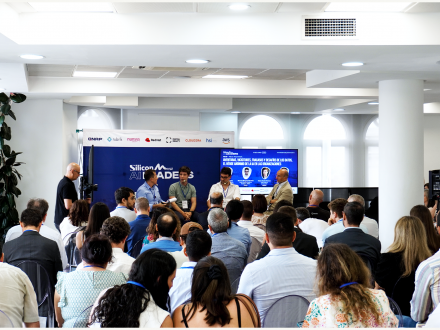
Storage, management, cybersecurity, ethics, talent… AI is revolutionising the way companies around the world approach Artificial Intelligence, the star of the Silicon conference.
Today, artificial intelligence is presented as the most promising and differentiating technology available to companies, users, and governments to make the qualitative leap they need in terms of digitisation and productivity.
A technology that, with artificial intelligence as its lever, continues to spread, and many companies and organisations of all sizes and sectors are already using it to, among other benefits, automate processes, improve customer relations, the supply chain, product quality, employee productivity and even create new business models or products.
Artificial intelligence is no longer a futuristic promise but has become an essential tool for driving growth and efficiency in any business.
Transforming business
The advanced digitisation of business processes, the increased capacity to collect, store and process data, advances in technology and changes in society itself have made artificial intelligence the most transformative element that all types of businesses will need to adopt in order to remain competitive.
The emergence of generative AI has further accelerated the transformation of organisations, inaugurating a range of new possibilities for all types of businesses, with use cases such as revolutionising efficiency through AI-driven agents or through ‘co-pilots’ that assist in all kinds of tasks.
However, beyond the hype and expectations, the use of AI and generative AI poses numerous challenges: from those related to business data and its governance, technological integration and the deployment and industrialisation of applications that use this AI, to changes in business culture and organisation, the need to incorporate new skills and staff training, and even the analysis of return on investment and regulatory compliance; all of these are challenges that must be addressed in order to successfully face this new era.
All of this was discussed at Silicon AI Leaders Day, an event that brought together technology experts as well as IT and business managers with a common goal: to share reflections, questions and best practices on this journey in which AI has become the driving force and vehicle.
AI and Strategy
A good example of shared experiences and lessons learned was the round table that inaugurated the event and its title: ‘Adventures, vicissitudes, failures and challenges of data, the anonymous hero of AI in organisations’.
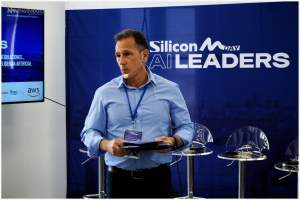
In recent years of frenetic activity to jump on the AI bandwagon, many organisations have made mistakes, generally by trying to embrace artificial intelligence without a proper strategy or roadmap.
Robert Assink, CEO of Digital Realty, pointed out that until recently ‘we only received projects from large companies, but today that has changed and SMEs are also getting started in AI.’ He asserted that it is essential to have ‘an artificial intelligence and data strategy in which the first big question should be how this technology will really help you to be better, more efficient, reduce your costs, etc.’
Data centres also play a major role in this scenario, as most AI applications and projects run on their infrastructures, which is why the sector itself is trying to respond to the new demands that this technology is generating.
‘There is a mismatch between the speed at which AI is growing and the process of building a data centre, which takes an average of three years,’ explained Assink.
In addition, centres that are already built are often unable to cope with the computing needs or data load that this technology requires. ‘These centres are also cooled with air, but this is not enough; we are studying how to cool them with water, which is feasible but also takes time, even if it is only a few months, and the problem is that AI apps have a time to market right now, right this minute.’
For her part, Simone Sfragano-Marriot, Lead Channel Engineer at Rubrik, said that we have finally entered a phase in which companies are beginning to understand the value of data and AI. ‘Previously, there were organisations that were implementing AI without value, like a fashionable toy, and others that tried to change everything for AI and, obviously, failed because the first thing we should be clear about is that artificial intelligence is a tool.’
As he pointed out, Rubrik itself has also adopted AI as a tool that ‘allows us to improve some of our services, such as identifying anomalies, from the last clean copy so that, if there is an attack, for example, we can recover the information, detect anomalies by analysing server behaviour, etc.’
He added, like Robert Assink, that ‘the most important thing is to know what you want to achieve with AI, to ask yourself that question, but above all not to become obsessed with it. See if it can really help you achieve your goal.’

That question has already been asked by Víctor Martin, Data Science Leader at Alstom, who explained how the company ‘is still in a learning process to discover and understand what, at the business level, is the use case that applies ROI to the business.’
Among the challenges, Martin pointed to data, ‘the prime matter of AI,’ because he explained that it is challenging to ensure its quality and even the very act of capturing, storing and transporting the data: ‘Often, for us, the data is in the middle of railway tracks.’
The Alstom spokesperson also added ‘the explainability of AI’ to the list of challenges, as well as talent, ‘which must be generated or attracted, but also retained.’
Data and how AI is transforming its storage
Governance, quality, traceability, but also, as we see, collection and storage. Data is the basis of any artificial intelligence development, or at least it should be if it is to be successful.
This means that everything must be adapted to a new way of managing and storing it, something QNAP is knowledgeable about.
Antonio Blanco, Alliance Manager at QNAP, explained at Silicon AI Leaders Day how QNAP storage technology is being optimised to respond to the challenges posed by AI: performance, scalability, efficiency and control.
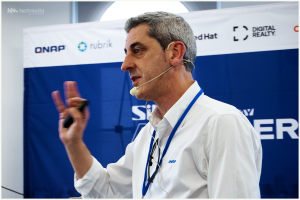
‘We have designed a line of solutions exclusively for AI needs, high-performance and high-capacity NAS, petabyte capacity, advanced connectivity… In a world where AI is becoming increasingly prevalent, a robust and efficient data storage infrastructure is essential,’ he shared.
He also advocated that in deploying artificial intelligence, data must be taken care of, since ‘the efficiency of AI depends on the quality of the data.’ In terms of this ‘care,’ the option QNAP advocates is ‘to use the organisation’s own information; to have reliable data, to be able to classify it, to provide feedback… If you don’t use your own information, from your organisation, you can’t ensure that it’s true, and therefore it has no value.’
He then gave attendees a demonstration of Qsirch, a search engine designed exclusively for QNAP NAS, which also allows users to easily switch between general search (keywords or AI-based semantic search) and RAG search to quickly find files stored on their NAS and enjoy an advanced data analysis experience. ‘It is also the most secure model, as confidential documents remain on the device,’ he assured.
Just like storage and data centres, Artificial Intelligence is bringing about a new way of understanding, even operating systems, and how to approach IT infrastructure.
This was made clear by Miguel Ángel Díaz, OpenShift Platform Leader, Spain & Portugal at Red Hat, who also stated that ‘just as we did with Linux or OpenShift, we want to be a market standard in the AI environment.’

To this end, he explained that, in addition to creating new products specifically designed for this technology, Red Hat has a very specific proposal: vLLMs.
‘The vLLM is a large virtual language model, an open source code library maintained by its own community that enables large language models (LLMs) to perform calculations more efficiently and as needed,’ shared Miguel Ángel Díaz.
Therefore, a vLLM is an inference server, ‘streamlines the results of generative artificial intelligence applications with better use of GPU memory and, therefore, enormous efficiency in resource consumption,’ he added.
Protecting information in the age of AI
Data governance and protection has become a top priority for organisations of all sizes, and with the integration of AI engines such as Copilot in Microsoft 365, this need has become essential.
‘When it comes to AI, we absolutely must set boundaries on the field,’ declared Rafael Vidal Iniesta, Head of Cybersecurity at Nunsys, during his speech at Silicon AI Leaders Day.

In his opinion, it is now more necessary than ever to protect and govern companies’ sensitive information and data, as the enormous growth in data volume, risks such as automated access, improper inferences, sensitive data leaks, etc., which are even more frequent with AI, ’also entail risks not only of regulatory sanctions but also serious reputational damage.’
For all these reasons, Nunsys advocates not only the protection of such data but also its proper governance: ‘Knowing who accesses what, where the information comes from, etc., something that is possible with Purview, thanks to a universal classification engine that can be used for DLP, internal risks, creating data maps, etc., in addition to the classification and protection of documents through tags,’ an ideal formula.
Additionally, Nunsys proposes SafeCloud, ‘our solution that allows organisations to know and govern all the information they manage (emails, office documents, databases, etc.),’ explained Rafael Vidal.
Does your organisation have superpowers?
Perhaps one of the most original needs expressed in the IT sector forums, and in this case at Silicon AI Leaders Day, was that of Daniel Torbellino, Telling Stories with AI Data & Analytics at Cloudera, who ‘literally’ wanted to demonstrate how to go one step further in AI, which requires superpowers.
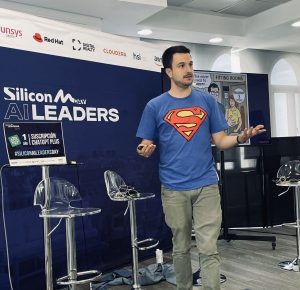
For example, with Superman’s S present, Torbellino asserted that ‘the first meta-power of AI is data governance, lineage, family, because we are who we are because of where we come from.’
Sustainability is another of the great superpowers needed in this new world where AI sets the pace for business. ‘Training an LLM involves emissions of 15,000 tonnes of CO2; we may not be able to remedy that, but we can control it by deciding, with our superpower, how we use AI. For example, choosing the programming language, the architecture or making smaller LLM models,’ he said, while asserting that “there can be no business AI without sustainable AI”.
And, of course, among so many superpowers and references to superheroes such as Superman, Daniel Torbellino concluded by stating that in this new scenario of Artificial Intelligence, ‘data is your kryptonite, it is what will differentiate you, your data and its quality.’
The new frontiers and challenges for AI
The Silicon event continued with bibliographical references and, of course, science fiction literature, which is very appropriate for the reality that AI is shaping. Daniel de Blas, director of Branded Content at Netmedia and master of ceremonies for the entire day, brought up Arthur C. Clarke, author of works such as ‘2001: A Space Odyssey,’ who claimed that ‘any sufficiently advanced technology is indistinguishable from magic.’
![]()
This is something that many people think when talking about artificial intelligence, but it was precisely this idea that was discussed at the round table ‘Magic vs. reality, scaling and profitability: new frontiers and challenges for AI’, where, in addition to the new LLM and the development of AI agents, other major challenges of this technology were analysed, such as awareness, education and change management within companies.
Carlos Benítez, Director of Business Development and Information Security at Pitarch Grupo Empresarial, explained how ‘knowing the ROI that an AI project will generate is a necessary step for management to approve it.’
This is not so simple and, in his opinion, ‘has to be accompanied by small pilot projects to test and see what truly adds value and what does not.’
In this regard, Carlos Gutiérrez, Innovation in Services Based on Microsoft Technologies at HSI, acknowledged that ‘projects with a very fast payback are necessary,’ for which ‘we look for patterns that allow me to select a technology stack that I trust so that I can calculate costs; in short, you have to look for small projects that generate value that you can then scale up.’
When asked about the main barriers that still exist in the adoption of artificial intelligence, Marcos Gritti, head of AI at Air Europa, pointed to ‘documentation, data, information governance, which is not always where it should be or in the form it should be, and of course, expectations, managing what people expect from AI, which they often see as something that can work magic and solve everything, and that’s not the case. It is a tool and that is how it should be seen.’

Gonzalo Durban, an independent consultant specialising in data governance, was tasked with considering how AI will change the future of businesses and the risks that its development may entail. ‘I really hope that we use AI to serve people ethically; otherwise, the alternative is frightening, especially because of the loss of critical thinking that it could bring to society.’
Empowering people, not ‘making us lazy’ and truly amplifying talent or the hybridisation of AI and people, eliminating barriers were other ‘wishes’ expressed by the participants in the round table discussion, after which it was the turn of Juanma Aramburu, CEO of Keepler, who analysed the AI operating model.
AI, observability and agents
Artificial Intelligence is transforming the operational foundations of companies and, with this, an operating model specific to this technology is emerging which, as Aramburu explained, is redefined in three key areas: management, demand and delivery.

‘Artificial Intelligence is here to stay, so my advice is to start now, with small projects, and scale up quickly,’ said the CEO of Keepler, who also pointed out that ’when AI is closer to the business and management, it is more transformational.’
The important thing, he reminded us, ‘is quality data and a data governance model’ as well as ‘observability, which must also be included in the design of the project itself and not at the end of it.’
And what better way to end the day than by looking to the future, with Eduardo Ordax, Go to Market GenAI at AWS for EMEA, who made no secret of the fact that there are still many challenges to overcome. ‘It is when we face the greatest challenges that the greatest discoveries are made, and that is precisely what is happening with AI today.’
![]()
After reviewing the evolution of AI, from large LLMs to inference time compute or reasoning models, to Agentic AI, ‘where the model analyses the problem, decides on the steps, plans and executes them; AI agents also have the ability to access external tools such as a database, retrieve more information, have both short- and long-term memory and, most importantly, have a feedback loop, feeding back to themselves in order to improve and correct themselves’.
In the near future, this will be the picture of AI, according to Ordax from AWS: ‘Agentic systems doing specific things and collaborating with each other. Now the challenge is to define that hierarchy, how those agents communicate and interact.’
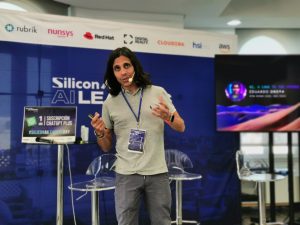
And, of course, the big question: ‘Is this true intelligence?’ Perhaps not at the moment, since, as Ordax stated, intelligence is much more than that; it is also emotional intelligence, common sense… Yet, indeed, we are still at the beginning, and there is much to be seen.
A future whose details we can barely glimpse, but which will undoubtedly be more intelligent (not just artificially), or it will not be.